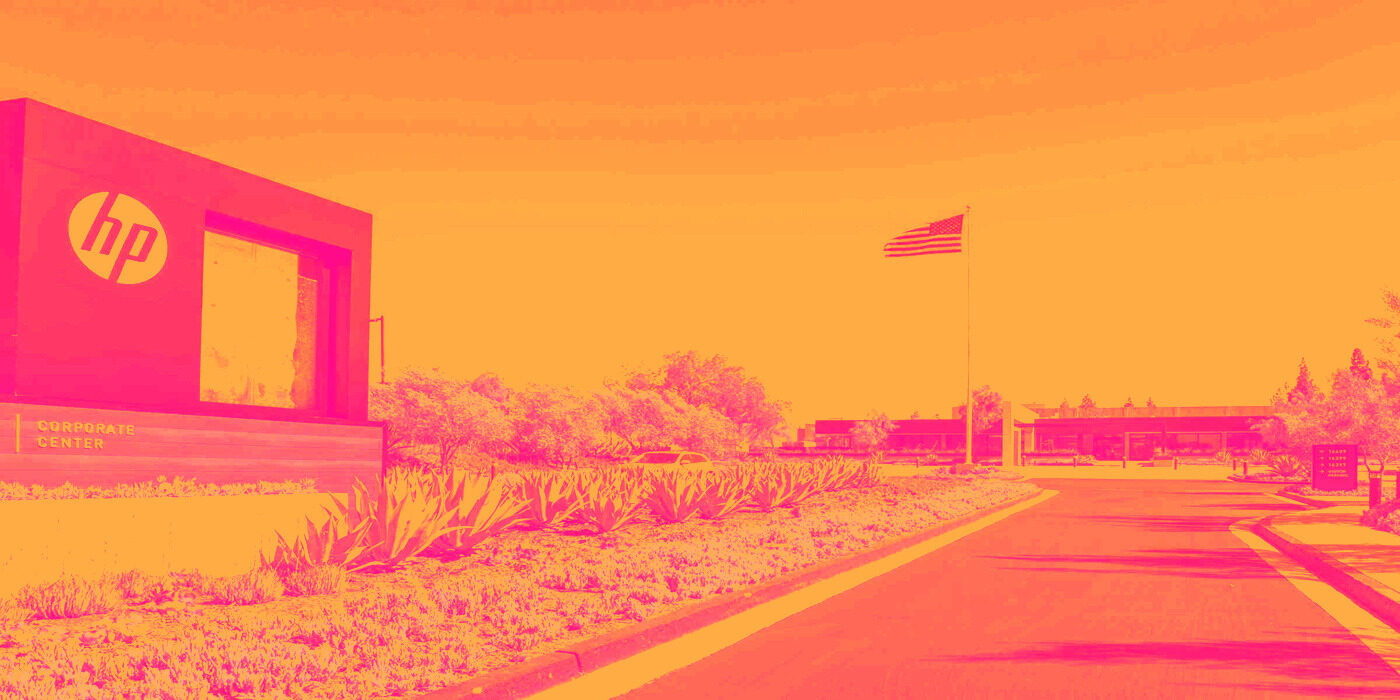HPQ Q3 Deep Dive: Memory Cost Surge and Print Weakness Shape Outlook

Personal computing and printing company HP (NYSE: HPQ) reported revenue ahead of Wall Streets expectations in Q3 CY2025, with sales up 4.2% year on year to $14.64 billion. Its non-GAAP profit of $0.93 per share was in line with analysts’ consensus estimates.
Is now the time to buy HPQ? Find out in our full research report (it’s free for active Edge members).
HP (HPQ) Q3 CY2025 Highlights:
- Revenue: $14.64 billion vs analyst estimates of $14.54 billion (4.2% year-on-year growth, 0.7% beat)
- Adjusted EPS: $0.93 vs analyst estimates of $0.92 (in line)
- Adjusted EBITDA: $1.32 billion vs analyst estimates of $1.44 billion (9% margin, 8.6% miss)
- Adjusted EPS guidance for the upcoming financial year 2026 is $3.05 at the midpoint, missing analyst estimates by 8.4%
- Operating Margin: 6.6%, in line with the same quarter last year
- Market Capitalization: $22.73 billion
StockStory’s Take
HP’s third quarter results drew a negative market reaction as investors focused on soft profitability despite revenue coming in slightly ahead of Wall Street expectations. Management attributed revenue growth to strength in Personal Systems, particularly commercial PCs and high-value devices, while Print continued to struggle with declining demand. CEO Enrique Lores noted, “We have driven sequential profit improvement the last two quarters,” but acknowledged that higher memory costs and a weak print hardware market weighed on overall margins. The company also referenced ongoing supply chain investments to mitigate these headwinds and highlighted recent leadership transitions as part of its evolving strategy.
Looking ahead, HP’s guidance for the next year reflects caution amid rising component costs and continued softness in printing. Management attributed its lower profit outlook to rapidly increasing memory prices and plans to offset these pressures through cost reductions, supplier diversification, and selective price increases. CFO Karen Parkhill emphasized, “We are prudently including these pressures in our outlook, yet we remain confident in the strength of our organization and partnership with our suppliers.” The company aims to expand higher-margin recurring revenue streams, especially subscriptions and services, but expects margin headwinds to persist until the second half of next year.
Key Insights from Management’s Remarks
Management highlighted the impact of memory cost inflation, supply chain actions, and strategic shifts in both Personal Systems and Print as key factors influencing the quarter and near-term outlook.
- Personal Systems momentum: Revenue growth was driven by commercial PCs and premium devices, with the Windows 11 refresh and increased adoption of AI-powered PCs (AIPCs) serving as tailwinds. Management noted that AIPCs made up over 30% of shipments in the quarter, and expects this mix to rise further.
- Print business under pressure: The print segment saw continued market softness and delayed purchasing, with consumer and commercial print units both declining year over year. HP maintained its number one share in print but cited competitive pricing and weak end-market demand as ongoing challenges.
- Cost management focus: Rising memory prices—now 15-18% of a typical PC’s cost—prompted HP to accelerate cost-cutting actions, qualify new suppliers, and redesign products for lower memory configurations. Management also plans targeted price increases to help offset input cost inflation.
- Subscription and recurring revenue growth: Double-digit expansion in consumer print subscriptions pushed annualized revenue in this segment close to $1 billion. The company also reported strong progress in workforce solutions and PC-as-a-Service offerings, viewing these as more stable, higher-margin revenue streams.
- Leadership changes and operational transformation: Recent executive hires in Personal Systems, Solutions, and Strategy reflect HP’s aim to blend internal and external talent for its next phase. The company is also launching a multi-year program to embed AI into operations, targeting $1 billion in cost savings and a workforce reduction of 4,000 to 6,000 employees over several years.
Drivers of Future Performance
HP’s outlook is shaped by memory cost inflation, ongoing weakness in printing, and a push toward higher-margin recurring revenue streams.
- Memory price headwinds: Management expects the sharp increase in memory prices to primarily affect margins in the second half of next year. HP plans to mitigate this through supplier diversification, lower-cost product configurations, and selective price increases, but flagged that full mitigation may not be possible.
- Print market decline and strategy: The company anticipates continued contraction in global print hardware demand, aiming to outperform by focusing on growth in Big Tank, industrial, and subscription-based offerings. Management expects competitive pricing and a secular decline in print to remain challenges.
- Recurring revenue focus: HP is investing in expanding its base of contractual, recurring revenue from subscriptions, workforce solutions, and services, with the goal of making profitability less cyclical and more stable over time. This transition is expected to be gradual but central to future margin improvement.
Catalysts in Upcoming Quarters
Looking ahead, the StockStory team will be watching (1) the trajectory of memory prices and HP’s ability to pass costs through to customers, (2) progress in expanding subscription and recurring revenue streams in both Personal Systems and Print, and (3) the effectiveness of new cost-saving initiatives, including AI-driven operational changes and leadership transitions. Execution on these fronts will be critical in navigating margin headwinds and stabilizing profitability.
HP currently trades at $23.06, down from $24.29 just before the earnings. Is the company at an inflection point that warrants a buy or sell? The answer lies in our full research report (it’s free for active Edge members).
Stocks That Trumped Tariffs
If your portfolio success hinges on just 4 stocks, your wealth is built on fragile ground. You have a small window to secure high-quality assets before the market widens and these prices disappear.
Don’t wait for the next volatility shock. Check out our Top 6 Stocks for this week. This is a curated list of our High Quality stocks that have generated a market-beating return of 244% over the last five years (as of June 30, 2025).
Stocks that have made our list include now familiar names such as Nvidia (+1,326% between June 2020 and June 2025) as well as under-the-radar businesses like the once-micro-cap company Kadant (+351% five-year return). Find your next big winner with StockStory today.
More News
View More




Recent Quotes
View More
Quotes delayed at least 20 minutes.
By accessing this page, you agree to the Privacy Policy and Terms Of Service.